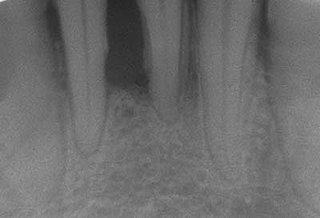
Periodontal disease, also known as gum disease, is a set of inflammatory conditions affecting the tissues surrounding the teeth. In its early stage, called gingivitis, the gums become swollen and red and may bleed. It is considered the main cause of tooth loss for adults worldwide. In its more serious form, called periodontitis, the gums can pull away from the tooth, bone can be lost, and the teeth may loosen or fall out. Bad breath may also occur.
Porphyromonas gingivalis belongs to the phylum Bacteroidota and is a nonmotile, Gram-negative, rod-shaped, anaerobic, pathogenic bacterium. It forms black colonies on blood agar.
Capnocytophaga is a genus of Gram-negative bacteria. Normally found in the oropharyngeal tract of mammals, they are involved in the pathogenesis of some animal bite wounds and periodontal diseases.
Aggregatibacter actinomycetemcomitans is a Gram-negative, facultative anaerobe, nonmotile bacterium that is often found in association with localized aggressive periodontitis, a severe infection of the periodontium. It is also suspected to be involved in chronic periodontitis. Less frequently, A. actinomycetemcomitans is associated with nonoral infections such as endocarditis. Its role in aggressive periodontitis was first discovered by Danish-born periodontist Jørgen Slots, a professor of dentistry and microbiology at the University of Southern California School of Dentistry.
Treponema denticola is a Gram-negative, obligate anaerobic, motile and highly proteolytic spirochete bacterium. It is one of four species of oral spirochetes to be reliably cultured, the others being Treponema pectinovorum, Treponema socranskii and Treponema vincentii. T. denticola dwells in a complex and diverse microbial community within the oral cavity and is highly specialized to survive in this environment. T. denticola is associated with the incidence and severity of human periodontal disease. Treponema denticola is one of three bacteria that form the Red Complex, the other two being Porphyromonas gingivalis and Tannerella forsythia. Together they form the major virulent pathogens that cause chronic periodontitis. Having elevated T. denticola levels in the mouth is considered one of the main etiological agents of periodontitis. T. denticola is related to the syphilis-causing obligate human pathogen, Treponema pallidum subsp. pallidum. It has also been isolated from women with bacterial vaginosis.
Laser-assisted new attachment procedure (LANAP) is a surgical therapy for the treatment of periodontitis, intended to work through regeneration rather than resection. This therapy and the laser used to perform it have been in use since 1994. It was developed by Robert H. Gregg II and Delwin McCarthy.
Prevotella is a genus of Gram-negative bacteria.
Prevotella intermedia is a gram-negative, obligate anaerobic pathogenic bacterium involved in periodontal infections, including gingivitis and periodontitis, and often found in acute necrotizing ulcerative gingivitis. It is commonly isolated from dental abscesses, where obligate anaerobes predominate.

Porphyromonas is a Gram-negative, non-spore-forming, obligately anaerobic and non-motile genus from the family Porphyromonadaceae. There were 16 different Porphyromonas species documented as of 2015, which reside in both animal and human reservoirs. It was discovered more recently that Porphyromonas also exist in the environment, albeit to a lesser extent. This genus is notably implicated in the modulation of oral cavity, respiratory tract, and gastrointestinal tract disease states. It is suggested that Porphyromonas either operate as benign bacteria pertinent to host immunity or are potential pathobionts that opportunistically provoke diseased states when homeostasis is disrupted. Despite its characterization not being fully elucidated due to sparse research, various studies report the prevalence of this genus at 58.7% in healthy states compared with 41.3% in diseased states.
Tannerella forsythia is an anaerobic, Gram-negative bacterial species of the Bacteroidota phylum. It has been implicated in periodontal diseases and is a member of the red complex of periodontal pathogens. T. forsythia was previously named Bacteroides forsythus and Tannerella forsythensis.
Chronic periodontitis is one of the seven categories of periodontitis as defined by the American Academy of Periodontology 1999 classification system. Chronic periodontitis is a common disease of the oral cavity consisting of chronic inflammation of the periodontal tissues that is caused by the accumulation of profuse amounts of dental plaque. Periodontitis initially begins as gingivitis and can progress onto chronic and subsequent aggressive periodontitis according to the 1999 classification.
Aggressive periodontitis describes a type of periodontal disease and includes two of the seven classifications of periodontitis as defined by the 1999 classification system:
- Localized aggressive periodontitis (LAP)
- Generalized aggressive periodontitis (GAP)
Periodontal pathogens are bacteria that have been shown to significantly contribute to periodontitis.
Xaa-Xaa-Pro tripeptidyl-peptidase is an enzyme. It catalyses the following chemical reaction
Prevotella nigrescens is a species of bacterium. Prevotella nigrescens has a gram negative gram stain. When P. nigrescens microflora colonize they trigger an over-aggressive response from the immune system and increase the incidence of many diseases and infections. One specific type of bacteria that is part of the normal oral flora but leads to disease when it infects the local tissue. This bacteria has no means of motility and has a Bacilli (rod) shape. Prevotella species are part of the human oral and vaginal flora. They play a role in the pathogenesis of periodontal disease, gingivitis, and extraoral infections such as nasopharyngeal and intra-abdominal infections also some odontogenic infections, and strains are usually carried in families, in so-called intrafamilial carriage. It is also associated with carotid atherosclerosis.
Prevotella brevis is a species of bacterium.
Prevotella bryantii, previously known as Bacteroides ruminicola subsp. brevis biovar 3, is a species of bacterium.
The BANA test is used to determine the proteolytic activity of certain oral anaerobes that contribute to oral malodor. Some bacteria, e.g. Prophyromona gingivalis, Treponema denticola, and Bacteroides forsythus produce waste products that are quite odiferous, and as a result contribute to bad breath.
Porphyromonas pasteri is a Gram-negative, obligately anaerobic, non-spore-forming and non-motile bacterium from the genus Porphyromonas which has been isolated from the human saliva. Porphyromonas pasteri is associated with periodontitis, a disease that can lead to tooth loss, and has also been linked to other systemic diseases such as cardiovascular disease, rheumatoid arthritis, and certain cancers.

